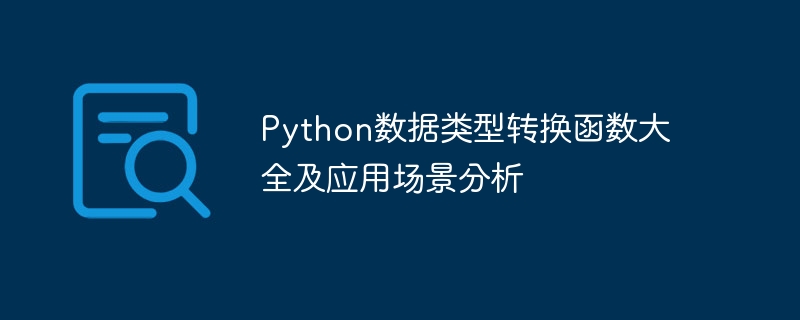

Comprehensive collection of Python data type conversion functions and application scenario analysis
[Introduction]
Data type conversion is a very common operation in programming, especially when processing When users enter data, data is stored and analyzed. As a dynamically typed language, Python provides a wealth of data type conversion functions to meet different needs. This article will introduce commonly used data type conversion functions in Python, list some common application scenarios, and give specific code examples.
[1. Integer conversion]
Application scenario:
Code example:
# 整数转换 x = "10" y = int(x) print(y) # 输出:10 # 进制转换 num = 10 binary_str = bin(num) print(binary_str) # 输出:0b1010
[2. Floating point number conversion]
Application scenarios:
Code example:
# 浮点数转换 x = "3.14" y = float(x) print(y) # 输出:3.14 # 浮点数舍入 num = 3.14159 rounded_num = round(num, 2) print(rounded_num) # 输出:3.14
[3. String conversion]
Application scenarios:
Code example:
# 对象转字符串 x = 100 y = str(x) print(y) # 输出:"100" # ASCII转换 asc_val = 65 char = chr(asc_val) print(char) # 输出:"A"
[4. List, tuple and set conversion]
Application scenarios:
Code example:
# 可迭代对象转列表
x = (1, 2, 3)
y = list(x)
print(y) # 输出:[1, 2, 3]
# 可迭代对象转元组
x = [1, 2, 3]
y = tuple(x)
print(y) # 输出:(1, 2, 3)
# 可迭代对象转集合
x = [1, 1, 2, 2, 3, 3]
y = set(x)
print(y) # 输出:{1, 2, 3}[5. Dictionary conversion]
Application scenario:
Code examples:
# 可迭代对象转字典
x = [("name", "Alice"), ("age", 20)]
y = dict(x)
print(y) # 输出:{"name": "Alice", "age": 20}[Conclusion]
This article introduces the commonly used data type conversion functions in Python, and gives specific application scenarios and code examples. In actual programming, rational use of data type conversion functions can improve the flexibility and readability of the code, while reducing potential problems caused by type errors. I hope this article can help readers in Python development.
The above is the detailed content of Comprehensive analysis of Python's data type conversion functions and their applicable scenarios. For more information, please follow other related articles on the PHP Chinese website!




